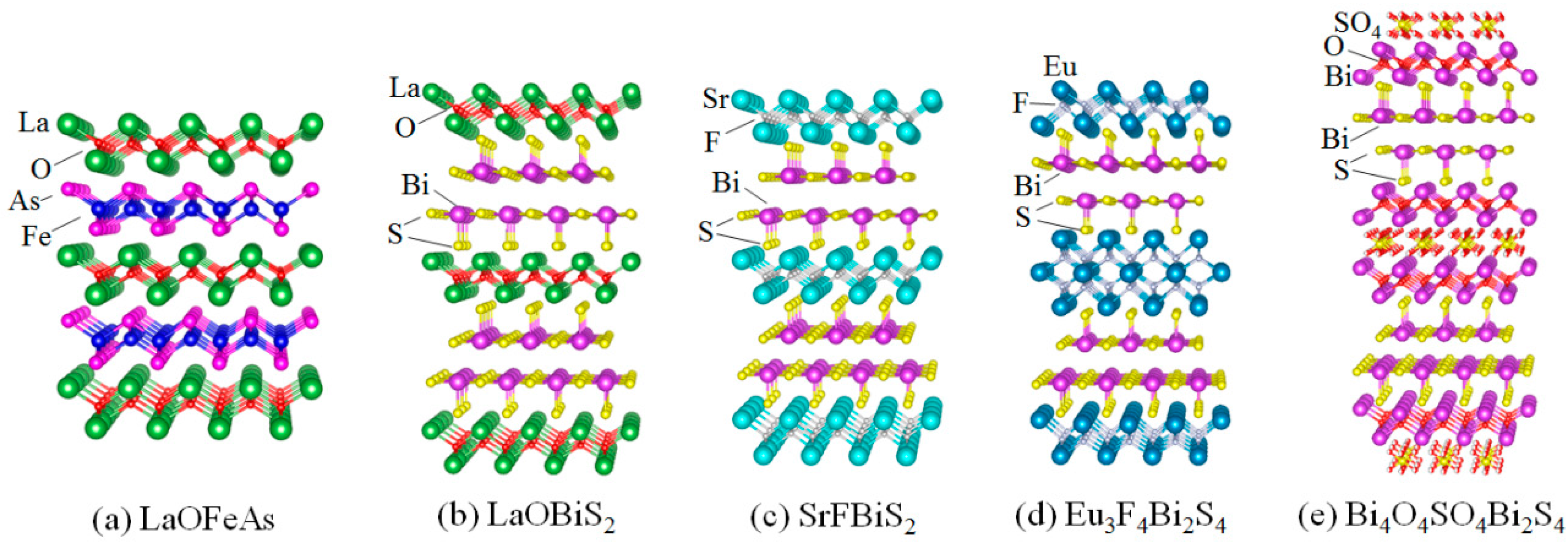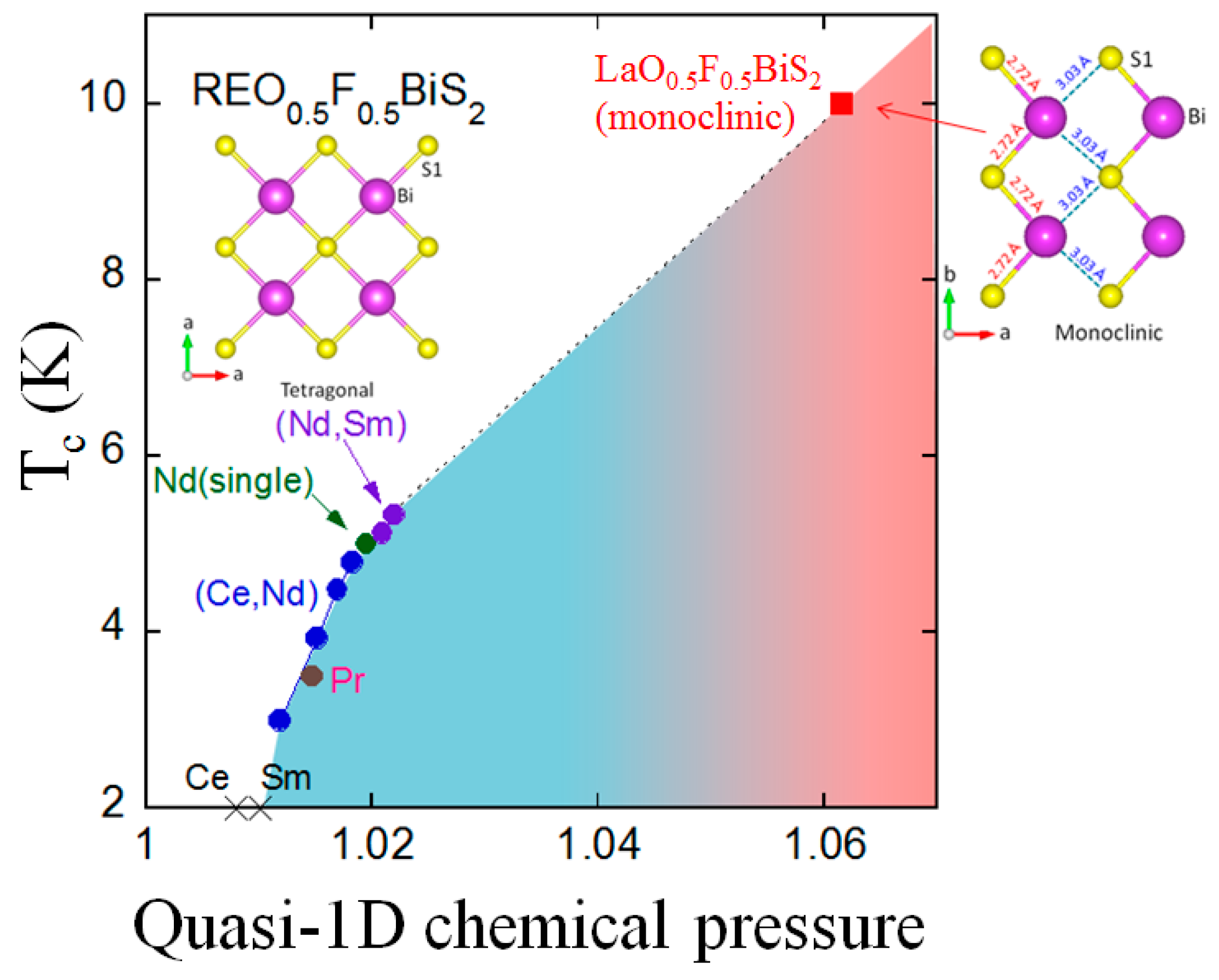Discovery of BiS2-Based Superconductor and Material Design Concept
Abstract
:1. Discovery of BiS2-Based Superconductor Family
1.1. Layered Superconductors
1.2. Discovery of the Bi–O–S Superconductor
1.3. 1112-Type BiS2-Based Superconductors
1.4. Other Bi-Chalcogenide Layered Compounds
2. Emergence of Superconductivity in BiS2-Based Compounds
2.1. Carrier Doping
2.2. External Pressure Effect
2.3. Chemical Pressure Effect
2.4. Importance of In-Plane Chemical Pressure
3. Material Design Strategies for the BiS2-Based Superconductor
4. Summary
Acknowledgments
Conflicts of Interest
References
- Kamihara, Y.; Watanabe, T.; Hirano, M.; Hosono, H. Iron-Based Layered Superconductor La[O1−xFx]FeAs (x = 0.05−0.12) with Tc = 26 K. J. Am. Chem. Soc. 2008, 130, 3296–3297. [Google Scholar] [CrossRef] [PubMed]
- Ishida, K.; Nakai, Y.; Hosono, H. To What Extent Iron-Pnictide New Superconductors Have Been Clarified: A Progress Report. J. Phys. Soc. Jpn. 2009, 78, 062001. [Google Scholar] [CrossRef]
- Bednorz, J.G.; Müller, K.A. Possible high Tc superconductivity in the Ba-La-Cu-O system. Z. Phys. B Condens. Matter 1986, 64, 189–193. [Google Scholar] [CrossRef]
- Liu, Y.; Zhao, L.D.; Liu, Y.; Lan, J.; Xu, W.; Li, F.; Zhang, B.P.; Berardan, D.; Dragoe, N.; Lin, Y.H.; et al. Remarkable Enhancement in Thermoelectric Performance of BiCuSeO by Cu Deficiencies. J. Am. Chem. Soc. 2011, 133, 20112–20115. [Google Scholar] [CrossRef] [PubMed]
- Momma, K.; Izumi, F. VESTA: A three-dimensional visualization system for electronic and structural analysis. J. Appl. Crystallogr. 2008, 41, 653–658. [Google Scholar] [CrossRef]
- Ubaldini, A.; Giannini, E.; Senatore, C.; van der Marel, D. BiOCuS: A new superconducting compound with oxypnictide-related structure. Physica C 2010, 470, S356–S357. [Google Scholar] [CrossRef]
- Pal, A.; Kishan, H.; Awana, V.P.S. Synthesis and Structural Details of BiOCu1−xS: Possible New Entrant in a Series of Exotic Superconductors? J. Supercond. Nov. Magn. 2010, 23, 301–304. [Google Scholar] [CrossRef]
- Mat Navi. Available online: http://mits.nims.go.jp/ (accessed on 26 January 2017).
- Mizuguchi, Y.; Fujihisa, H.; Gotoh, Y.; Suzuki, K.; Usui, H.; Kuroki, K.; Demura, S.; Takano, Y.; Izawa, H.; Miura, O. BiS2-based layered superconductor Bi4O4S3. Phys. Rev. B 2012, 86, 220510. [Google Scholar] [CrossRef]
- Tanryverdiev, V.S.; Aliev, O.M.; Aliev, I.I. Synthesis and physicochemical properties of LnBiOS2. Inorg. Mater. 1995, 31, 1497–1498. [Google Scholar]
- Mizuguchi, Y.; Demura, S.; Deguchi, K.; Takano, Y.; Fujihisa, H.; Gotoh, Y.; Izawa, H.; Miura, O. Superconductivity in Novel BiS2-Based Layered Superconductor LaO1−xFxBiS2. J. Phys. Soc. Jpn. 2012, 81, 114725. [Google Scholar] [CrossRef]
- Usui, H.; Suzuki, K.; Kuroki, K. Minimal electronic models for superconducting BiS2 layers. Phys. Rev. B 2012, 86, 220501. [Google Scholar] [CrossRef]
- Tomita, T.; Ebata, M.; Soeda, H.; Takahashi, H.; Fujihisa, H.; Gotoh, Y.; Mizuguchi, Y.; Izawa, H.; Miura, O.; Demura, S.; et al. Pressure-induced Enhancement of Superconductivity in BiS2-layered LaO1−xFxBiS2. J. Phys. Soc. Jpn. 2014, 83, 063704. [Google Scholar] [CrossRef]
- Wolowiec, C.T.; Yazici, D.; White, B.D.; Huang, K.; Maple, M.B. Pressure-induced enhancement of superconductivity and suppression of semiconducting behavior in LnO0.5F0.5BiS2 (Ln = La, Ce) compounds. Phys. Rev. B 2013, 88, 064503. [Google Scholar] [CrossRef]
- Wolowiec, C.T.; White, B.D.; Jeon, I.; Yazici, D.; Huang, K.; Maple, M.B. Enhancement of superconductivity near the pressure-induced semiconductor-metal transition in BiS2-based superconductors LnO0.5F0.5BiS2 (Ln = La, Ce, Pr, Nd). J. Phys. Condens. Matter 2013, 25, 422201. [Google Scholar] [CrossRef] [PubMed]
- Kotegawa, H.; Tomita, Y.; Tou, H.; Izawa, H.; Mizuguchi, Y.; Miura, O.; Demura, S.; Deguchi, K.; Takano, Y. Pressure Study of BiS2-Based Superconductors Bi4O4S3 and La(O,F)BiS2. J. Phys. Soc. Jpn. 2012, 81, 103702. [Google Scholar] [CrossRef]
- Deguchi, K.; Mizuguchi, Y.; Demura, S.; Hara, H.; Watanabe, T.; Denholme, S.J.; Fujioka, M.; Okazaki, H.; Ozaki, T.; Takeya, H.; et al. Evolution of superconductivity in LaO1−xFxBiS2 prepared by high pressure technique. EPL 2013, 101, 17004. [Google Scholar] [CrossRef]
- Kajitani, J.; Deguchi, K.; Omachi, A.; Hiroi, T.; Takano, Y.; Takatsu, H.; Kadowaki, H.; Miura, O.; Mizuguchi, Y. Correlation between crystal structure and superconductivity in LaO0.5F0.5BiS2. Solid State Commun. 2014, 181, 1–4. [Google Scholar] [CrossRef]
- Xing, J.; Li, S.; Ding, X.; Yang, H.; Wen, H.H. Superconductivity Appears in the Vicinity of an Insulating-Like Behavior in CeO1−xFxBiS2. Phys. Rev. B 2012, 86, 214518. [Google Scholar] [CrossRef]
- Demura, S.; Deguchi, K.; Mizuguchi, Y.; Sato, K.; Honjyo, R.; Yamashita, A.; Yamaki, T.; Hara, H.; Watanabe, T.; Denholme, S.J.; et al. Coexistence of bulk superconductivity and ferromagnetism in CeO1−xFxBiS2. J. Phys. Soc. Jpn. 2015, 84, 024709. [Google Scholar] [CrossRef]
- Jha, R.; Kumar, A.; Singh, S.K.; Awana, V.P.S. Synthesis and superconductivity of new BiS2 based superconductor PrO0.5F0.5BiS2. J. Supercond. Nov. Magn. 2012, 26, 499–502. [Google Scholar] [CrossRef]
- Demura, S.; Mizuguchi, Y.; Deguchi, K.; Okazaki, H.; Hara, H.; Watanabe, T.; Denholme, S.J.; Fujioka, M.; Ozaki, T.; Fujihisa, H.; et al. BiS2-based superconductivity in F-substituted NdOBiS2. J. Phys. Soc. Jpn. 2013, 82, 033708. [Google Scholar] [CrossRef]
- Kajitani, J.; Hiroi, T.; Omachi, A.; Miura, O.; Mizuguchi, Y. Chemical pressure effect on superconductivity of BiS2-based Ce1−xNdxO1−yFyBiS2 and Nd1−zSmzO1−yFyBiS2. J. Phys. Soc. Jpn. 2015, 84, 044712. [Google Scholar] [CrossRef]
- Thakur, G.S.; Selvan, G.K.; Haque, Z.; Gupta, L.C.; Samal, S.L.; Arumugam, S.; Ganguli, A.K. Synthesis and properties of SmO0.5F0.5BiS2 and enhancement in Tc in La1−ySmyO0.5F0.5BiS2. Inorg. Chem. 2015, 54, 1076–1081. [Google Scholar] [CrossRef] [PubMed]
- Lei, H.; Wang, K.; Abeykoon, M.; Bozin, E.S.; Petrovic, C. New layered oxysulfide SrFBiS2. Inorg. Chem. 2013, 52, 10685. [Google Scholar] [CrossRef] [PubMed]
- Lin, X.; Ni, X.; Chen, B.; Xu, X.; Yang, X.; Dai, J.; Li, Y.; Yang, X.; Luo, Y.; Tao, Q.; et al. Superconductivity induced by La doping in Sr1−xLaxFBiS2. Phys. Rev. B 2013, 87, 020504. [Google Scholar] [CrossRef]
- Zhai, H.F.; Tang, Z.T.; Jiang, H.; Xu, K.; Zhang, K.; Zhang, P.; Bao, J.K.; Sun, Y.L.; Jiao, W.H.; Nowik, I.; et al. Possible Charge-density wave, superconductivity and f-electron valence instability in EuBiS2F. Phys. Rev. B 2014, 90, 064518. [Google Scholar] [CrossRef]
- Jha, R.; Tiwari, B.; Awana, V.P.S. Appearance of bulk Superconductivity under Hydrostatic Pressure in Sr0.5RE0.5FBiS2 (RE = Ce, Nd, Pr and Sm) new compounds. J. Appl. Phys. 2015, 117, 013901. [Google Scholar] [CrossRef]
- Zhai, H.F.; Zhang, P.; Wu, S.Q.; He, C.Y.; Tang, Z.T.; Jiang, H.; Sun, Y.L.; Bao, J.K.; Nowik, I.; Felner, I.; et al. Anomalous Eu Valence State and Superconductivity in Undoped Eu3Bi2S4F4. J. Am. Chem. Soc. 2014, 136, 15386–15393. [Google Scholar] [CrossRef] [PubMed]
- Luo, Y.; Zhai, H.F.; Zhang, P.; Xu, Z.A.; Cao, G.H.; Thompson, J.D. Pressure-enhanced superconductivity in Eu3Bi2S4F4. Phys. Rev. B 2014, 90, 220510. [Google Scholar] [CrossRef]
- Zhang, P.; Zhai, H.F.; Tang, Z.J.; Li, L.; Li, Y.K.; Chen, Q.; Chen, J.; Wang, Z.; Feng, C.M.; Cao, G.H.; et al. Superconductivity enhanced by Se doping in Eu3Bi2(S,Se)4F4. EPL 2015, 111, 27002. [Google Scholar] [CrossRef]
- Sun, Y.L.; Ablimit, A.; Zhai, H.F.; Bao, J.K.; Tang, Z.T.; Wang, X.B.; Wang, N.L.; Feng, C.M.; Cao, G.H. Design and Synthesis of a New Layered Thermoelectric Material LaPbBiS3O. Inorg. Chem. 2014, 53, 11125–11129. [Google Scholar] [CrossRef] [PubMed]
- Li, L.; Parker, D.; Babkevich, P.; Yang, L.; Ronnow, H.M.; Sefat, A.S. Superconductivity in semimetallic Bi3O2S3. Phys. Rev. B 2015, 91, 104511. [Google Scholar] [CrossRef]
- Higashinaka, R.; Miyazaki, R.; Mizuguchi, Y.; Miura, O.; Aoki, Y. Low-Temperature Enhancement in the Upper Critical Field of Underdoped LaO1−xFxBiS2 (x = 0.1–0.3). J. Phys. Soc. Jpn. 2014, 83, 075004. [Google Scholar] [CrossRef]
- Jha, R.; Awana, V.P.S. Effect of Hydrostatic Pressure on BiS2-Based Layered Superconductors: A Review. Nov. Supercond. Mater. 2016, 2, 2299–3193. [Google Scholar] [CrossRef]
- Sagayama, R.; Sagayama, H.; Kumai, R.; Murakami, Y.; Asano, T.; Kajitani, J.; Higashinaka, R.; Matsuda, T.D.; Aoki, Y. Symmetry Lowering in LaOBiS2: A Mother Material for BiS2-Based Layered Superconductors. J. Phys. Soc. Jpn. 2015, 84, 123703. [Google Scholar] [CrossRef]
- Liu, Q.; Zhang, X.; Zunger, A. Polytypism in LaOBiS2-type compounds based on different three-dimensional stacking sequences of two-dimensional BiS2 layers. Phys. Rev. B 2016, 93, 174119. [Google Scholar] [CrossRef]
- Hiroi, T.; Kajitani, J.; Omachi, A.; Miura, O.; Mizuguchi, Y. Evolution of superconductivity in BiS2-based superconductor LaO0.5F0.5Bi(S1−xSex)2. J. Phys. Soc. Jpn. 2015, 84, 024723. [Google Scholar] [CrossRef]
- Mizuguchi, Y.; Miura, A.; Kajitani, J.; Hiroi, T.; Miura, O.; Tadanaga, K.; Kumada, N.; Magome, E.; Moriyoshi, C.; Kuroiwa, Y. In-plane chemical pressure essential for superconductivity in BiCh2-based (Ch: S, Se) layered structure. Sci. Rep. 2015, 5, 14968. [Google Scholar] [CrossRef] [PubMed]
- Jinno, G.; Jha, R.; Yamada, A.; Higashinaka, R.; Matsuda, T.D.; Aoki, Y.; Nagao, M.; Miura, O.; Mizuguchi, Y. Bulk Superconductivity Induced by In-plane Chemical Pressure Effect in Eu0.5La0.5FBiS2–xSex. J. Phys. Soc. Jpn. 2016, 85, 124708. [Google Scholar] [CrossRef]
- Ricci, A.; Poccia, N.; Joseph, B.; Arrighetti, G.; Barba, L.; Plaisier, J.; Campi, G.; Mizuguchi, Y.; Takeya, H.; Takano, Y.; Saini, N.L.; Bianconi, A. Intrinsic phase separation in superconducting K0.8Fe1.6Se2 (Tc = 31.8 K) single crystals. Supercond. Sci. Technol. 2011, 24, 082002. [Google Scholar] [CrossRef]
- Kugel, K.I.; Rakhmanov, A.L.; Sboychakov, A.O.; Kusmartsev, F.V.; Poccia, N.; Bianconi, A. A two-band model for the phase separation induced by the chemical mismatch pressure in different cuprate superconductors. Supercond. Sci. Technol. 2009, 22, 014007. [Google Scholar] [CrossRef]
- Poccia, N.; Ricci, A.; Bianconi, A. Misfit Strain in Superlattices Controlling the Electron-Lattice Interaction via Microstrain in Active Layers. Adv. Condens. Matter Phys. 2010, 2010, 261849. [Google Scholar] [CrossRef]
- Bianconi, A.; Di Castro, D.; Bianconi, G.; Pifferi, A.; Saini, N.L.; Chou, F.C.; Johnston, D.C.; Colapietro, M. Coexistence of stripes and superconductivity: Tc amplification in a superlattice of superconducting stripes. Physica C 2000, 341–348, 1719–1722. [Google Scholar] [CrossRef]
- Bendele, M.; Barinov, A.; Joseph, B.; Innocenti, D.; Iadecola, A.; Bianconi, A.; Takeya, H.; Mizuguchi, Y.; Takano, Y.; Noji, T.; et al. Spectromicroscopy of electronic phase separation in KxFe2−ySe2 superconductor. Sci. Rep. 2014, 4, 5592. [Google Scholar] [CrossRef] [PubMed]
- Athauda, A.; Yang, J.; Lee, S.; Mizuguchi, Y.; Deguchi, K.; Takano, Y.; Miura, O.; Louca, D. In-plane Charge Fluctuations in Bismuth Sulfide Superconductors. Phys. Rev. B 2014, 91, 144112. [Google Scholar] [CrossRef]
- Mizuguchi, Y.; Paris, E.; Sugimoto, T.; Iadecola, A.; Kajitani, J.; Miura, O.; Mizokawa, T.; Saini, N.L. The effect of RE substitution in layered REO0.5F0.5BiS2: Chemical pressure, local disorder and superconductivity. Phys. Chem. Chem. Phys. 2015, 17, 22090–22096. [Google Scholar] [CrossRef] [PubMed]
- Paris, E.; Joseph, B.; Iadecola, A.; Sugimoto, T.; Olivi, L.; Demura, S.; Mizuguchi, Y.; Takano, Y.; Mizokawa, T.; Saini, N.L. Determination of local atomic displacements in CeO1−xFxBiS2 system. J. Phys. Condens. Matter 2014, 26, 435701. [Google Scholar] [CrossRef] [PubMed]
- Mizuguchi, Y.; Miura, A.; Nishida, A.; Miura, O.; Tadanaga, K.; Kumada, N.; Lee, C.H.; Magome, E.; Moriyoshi, C.; Kuroiwa, Y. Compositional and temperature evolution of crystal structure of new thermoelectric compound LaOBiS2−xSex. J. Appl. Phys. 2016, 119, 155103. [Google Scholar] [CrossRef]





© 2017 by the author; licensee MDPI, Basel, Switzerland. This article is an open access article distributed under the terms and conditions of the Creative Commons Attribution (CC BY) license ( http://creativecommons.org/licenses/by/4.0/).
Share and Cite
Mizuguchi, Y. Discovery of BiS2-Based Superconductor and Material Design Concept. Condens. Matter 2017, 2, 6. https://doi.org/10.3390/condmat2010006
Mizuguchi Y. Discovery of BiS2-Based Superconductor and Material Design Concept. Condensed Matter. 2017; 2(1):6. https://doi.org/10.3390/condmat2010006
Chicago/Turabian StyleMizuguchi, Yoshikazu. 2017. "Discovery of BiS2-Based Superconductor and Material Design Concept" Condensed Matter 2, no. 1: 6. https://doi.org/10.3390/condmat2010006
APA StyleMizuguchi, Y. (2017). Discovery of BiS2-Based Superconductor and Material Design Concept. Condensed Matter, 2(1), 6. https://doi.org/10.3390/condmat2010006



